Group of architects create region’s largest 3D-printed building in just 140 hours

A large European structure, dubbed by its creators as the Wave House, took just 140 hours to build, thanks to 3D printing technology.
It’s the result of a collaboration of several firms and tech experts to build a unique, stylish cloud-computing data center in Heidelberg, Germany, the largest 3D-printed structure on the continent, according to a story by New Atlas.
In addition to a design that lives up to its ocean-themed name, the build is also another success story for the unique construction concept.
The printer, which looks like a scaffolding rig that moves across the top of the build site, lets loose a recyclable “cement-like mixture” in layers. The slurry comes out at 43 square feet per hour, forming the outside walls. The process releases “significantly less” air pollution than traditional methods, all per New Atlas.
The unique facility, at 600 square meters (about 6458 square feet), was designed by SSV and Mense Korte, printed by Peri 3D Construction for KrausGruppe, the developer.
“A challenge … in the Heidelberg project was solved by the architects … by giving the walls a wave design, a design feature that also gave name to the building: the Wave House. Such wave designed walls could not have been realized using conventional construction methods, so instead 3D construction printing technology was used due to the design freedom of this construction method,” said a press release about the project, quoted by New Atlas.
#cool_newsletter_f68c1387-cccd-4982-8bf7-77f2fc5e1d7e .cool_newsletter__inner span{color:#000000}
Join our newsletter
Good news, green hacks, and the latest cool clean tech — straight to your inbox every week!
A time-lapse video highlights the impressive size and maneuvering capability of the printer, showing it traveling back and forth over the structure, adding a layer of material with each pass.
[embedded content]
The result is a building that looks fit for a Hollywood movie set, with vertical ridges, cylindrical elements, and wave-like designs. A human crew finished the roof, doors, wiring, and some other parts of the build.
Standard materials used to construct buildings generate about 9% of global air pollution. What’s more, “raw resource use” is forecast to double by 2060. Steel, concrete, and cement are among the building elements noted in a United Nations report on the sector’s impact on planet overheating.
Other concepts being developed to clean up some of the pollution from the construction sector include a cement alternative made from fungus, called mycocrete. And in the United States, 3D-printed communities are growing, utilizing the efficiency of the tech.
The innovations are important in more ways than one. By reducing planet-warming air pollution, we can improve sustainability for our food system, as climate-worsened storms, droughts, and other weather patterns are impacting the agriculture sector, including food prices.
Unique 3D-printed buildings like the Wave House could become a more standard part of efforts to quickly and sustainably construct buildings. For typically utilitarian structures like data centers, the result can even be a bit artistic.
“The trend toward making data centers more in the vicinity of the users and therefore locate them in suburban areas and cities has created a need to make the data centers more visually appealing,” New Atlas reported, quoting the press release on the project.
Join our free newsletter for weekly updates on the coolest innovations improving our lives and saving our planet.
Are 3D Printed Data Centres a Viable Sustainable Solution?
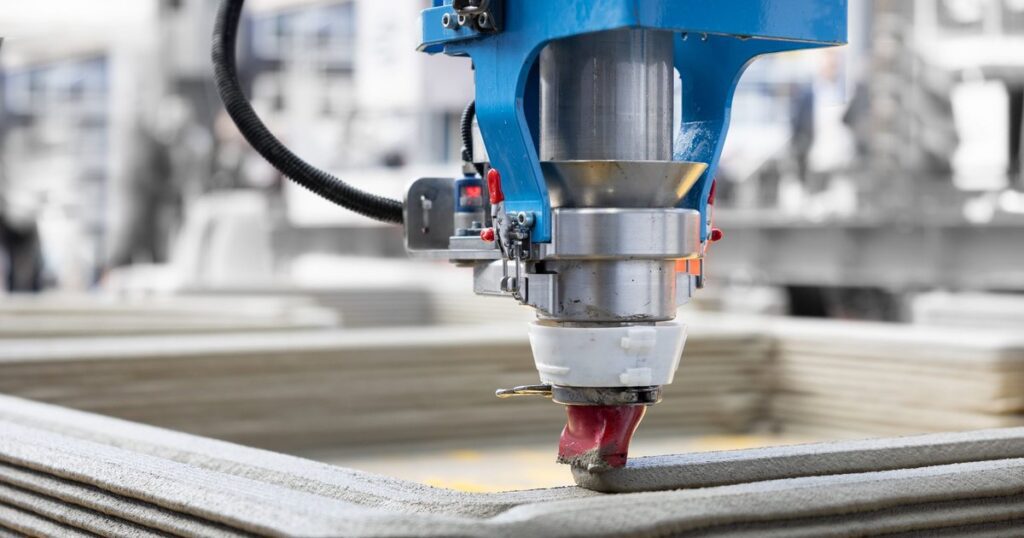
Speaking on the project’s completion, COBOD highlighted a growing trend towards making data centres more in the vicinity of the users and to therefore locate them in suburban areas and cities. As a result, data centre developers are starting to focus on the need to make data centres more visually appealing.Additionally, it was a cost-saver, with Hans-Jörg Kraus, Managing Partner of KRAUS GRUPPE Heidelberg, commenting on the amount saved via 3D construction printing.
“I cannot tell you what it would cost if we had made the data centre conventionally,” he said. “3D construction printing made this project economically viable”.
In addition to saving time and cost, constructing 3D printed data centres could also lead to more customised solutions being created to suit a wide range of functions and situations. This is ideal for a data centre facility, given that supply and demand is swelling rapidly around the world on account of technologies such as artificial intelligence (AI).
3D printed construction has also been hailed as energy efficient, as it means that developers are using fewer resources and creating less waste. Enhanced sustainability solutions can result in greater economic success for businesses, which could be particularly useful when considering the amount of power and energy data centres currently use.
This type of construction could result in data centres being able to experiment more with the appearance and contents of their site and creating more opportunities for innovation.
Associated challenges: Does this plan have a design flaw?
Despite such forward-thinking progress, 3D printed data centres could result in some challenges, including job cuts, design inaccuracies and even a lack of reinforcement if not considered correctly.
As 3D printed buildings enter further into public consciousness, and even city centres, debates could arise over the strength of these structures and how much they can contain.
Speaking in a LinkedIn post, General Manager Cloud at Cyberlink AG, Maximilian Wellenhofer, comments on how data centres would need to incorporate reinforcement techniques to address these potential issues.
“These challenges notwithstanding, the project in Heidelberg – and the broader push towards 3D-printed structures – opens up a dialogue about the future of construction in high-risk areas, including those prone to earthquakes,” he highlights. “The industry must address structural integrity and resilience against natural disasters, ensuring these innovative structures can withstand such events without compromising safety or functionality.”
He adds: “This approach not only highlights the potential for more efficient building methods but also prompts a significant question: can the architectural design of 3D-printed structures be optimised for natural cooling processes to reduce power consumption for cooling?”
******
Make sure you check out the latest edition of Data Centre Magazine and also sign up to our global conference series – Tech & AI LIVE 2024
******
Data Centre Magazine is a BizClik brand
Portugal’s first 3D printed house

Could 3D printing be the future for housing? Today we’re taking a look at what will be the first Portuguese house “built” using a 3D printer in Portela da Villa, in Torres Vedras. It will be built by Litehaus.The company that links cutting-edge technology to the real estate sector aims to “bring a sustainable and innovative solution to the [construction] industry, which is responsible for 42% of carbon emissions”. The process of creating this residential unit was carried out using technologies such as Artificial Intelligence, in an initial phase of creativity and projection, and 3D printing already in its building.In a statement, Litehaus explains that it wants to focus on the production of modular buildings and 3D-printed houses, which consume 67 per cent less energy to manufacture. The aim, it says, is to build 100 houses a year in Portugal.”We’re here to make the sector wary. This technology allows us to produce up to 45m2 of walls in just 20 hours,” says Simi Launay, Litehaus’ Chief Creative Officer.”Litehaus is embarking on a mission to redefine living spaces, fusing AI technology, 3D printing and modular homes to create buildings that echo simplicity, innovation and sustainability. Our goal is to build 70% faster and 20% cheaper, building homes that epitomise elegance and minimalism harmonised with Portugal’s natural beauty,” he adds.
COBOD Launched VR Solution for 3D Construction Printing
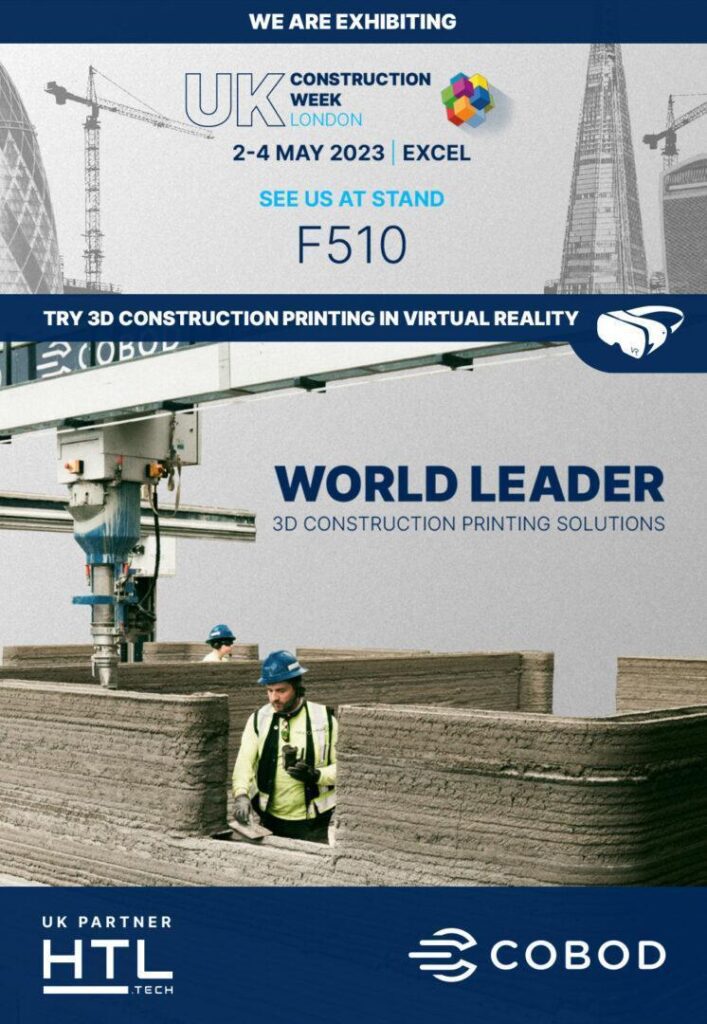
COBOD has launched a VR solution for 3D construction printing, allowing people to experience live 3D printing in virtual reality. The VR solution offers a realistic experience, allowing individuals to watch COBOD’s real printed buildings being constructed in a virtual residential area. COBOD will present the VR solution at UK Construction Week, London, from May […]
Printing Swedish houses with algae
For the first time, a new material made from tiny cellulose fibers and algae has been tried as a more environmentally friendly option for construction.
Researchers from Chalmers University of Technology and the Wallenberg Wood Science Center in Sweden experimented with this sustainable material and found it can be used to create various architectural components using less energy than traditional methods.
The construction industry is a major contributor to global pollution, using half of the world’s fossil fuels, generating 40% of waste, and producing 39% of carbon dioxide emissions. To combat this, scientists are exploring biomaterials like nanocellulose, which is already used in biomedicine for its ability to be 3D printed into structures for tissue growth. This study marks the first attempt to use dried nanocellulose in architecture.
By mixing nanocellulose fibers with water and an algae-based substance called alginate, the researchers created a material that could be 3D printed. This blend provided flexibility to the material when it dried, enabling its use in architectural applications.
The use of 3D printing in architecture is seen as a resource-efficient method. Unlike traditional methods that produce waste, 3D printing requires fewer materials and less energy, particularly when using a robotic system that operates at room temperature. The properties of the nanocellulose hydrogel allow it to be easily printed and maintain its shape without requiring high temperatures.
The researchers tested various printing techniques to understand how the material behaves when dried in different shapes. These dried shapes could be used to create lightweight architectural elements such as room dividers, blinds, wall panels, and coatings for existing building components.
This study lays the groundwork for further exploration of nanocellulose in architectural design, highlighting the need for new approaches to incorporate biobased materials into buildings. Understanding the properties and design possibilities of these materials is crucial for creating sustainable and aesthetically pleasing structures that align with the goals of a circular economy.
Robotically 3D printed architectural membranes from ambient dried cellulose nanofibril-alginate hydrogel“, published in the journal Materials and Design.
#GreenBuilding #SustainableDesign #Nanocellulose #Architecture
Completed Data Center Is Europe’s Largest 3D Printed Building – 3DPrint.com | The Voice of 3D Printing / Additive Manufacturing

As exciting as 3D printed homes are, particularly when part of a feel-good story, it is the industrial applications of the technology that may represent the maturity of the additive construction (AC) sector. This is made evident with the completion of Europe’s largest 3D printed building, the Wavehouse data center in Germany, which is described as the first of its kind in the industrial and data center sectors globally.
Developed by Kraus Group, with participation from architecture firms Mense-Korte and SSV, this single-story facility is situated in the Baden-Württemberg region of Heidelberg. It took the PERI Group, an investor in AC firm COBOD, about 140 hours to complete the nearly 600-square-meter building using a BOD2 3D printer. According to the companies involved, about 450 tons of printing concrete, provided by Heidelberg Materials, were used. This material is described as both 100% recyclable and featuring a binder capable of achieving a 55% CO2 reduction compared to traditional Portland cement.
Building Leaders Serious about Construction 3D Printing
Founded in 1874, Heidelberg Materials is a €21.095 billion company, with 57,000 employees working at 3,000 production sites across 60 countries. This puts it on par with COBOD investor and materials company Holcim and somewhat ahead of COBOD investor and materials company CEMEX, as well as Swiss AC backer and materials company Sika. All are less than half the size of the €51.2 billion French materials giant Saint-Gobain, which is pursuing AC through its Weber Beamix subsidiary. There are only some of the leading construction businesses exploring the technology, but they are representative enough to demonstrate just how serious the sector has become.
What’s also interesting is the overlap by these firms in the AC space. As noted, several are COBOD investors, while both PERI Group and Sika have backed another construction 3D printing startup, Mesh AG. The technology of COBOD and Mesh are complementary, in that Mesh can 3D print steel reinforcement for 3D printed buildings, such as those made with COBOD’s machines. However, one would think of Sika, Holcim, and CEMEX as competitors. Obviously in global business, multinational corporations share much in common and similar goals in terms of “growing the pie,” but the extent to which these frenemies can coexist investing in the same startup is difficult to foresee.
Construction 3D Printing and Infrastructure, Growing Together
The Wavehouse will be operated by Heidelberg iT Management, a local cloud and data center provider with a history dating back to 2001. The center is expected to offer 500kW of power and accommodate around 100 racks. While the facility’s 3D printed shell has been completed, the total job is expected to be finished by the end of the summer.
While the Wavehouse is a more traditional form of data center, EdgeCloudLink in the United States plans to pursue the construction of hydrogen-powered, off-grid modular data centers built using 3D printing. The market for data center construction is massive, with some analysts projecting a seven percent growth from $250.4 billion in 2023 to $270.07 billion in 2024. This makes sense given the growing need for servers in general, thanks to such technologies as artificial intelligence and cloud computing.
In order to keep up with demand, builders will likely turn increasingly to AC as a means of constructing these structures more quickly, while also demonstrating the ability of 3D printing to make facilities that can meet the requirements of data centers in terms of cooling and structural integrity. This trend would complement other infrastructure projects that AC will certainly play a role in, such as new rail systems, power generation, disaster relief, and general construction.
All images courtesy of Heidelberg Materials.
Subscribe to Our Email Newsletter
Stay up-to-date on all the latest news from the 3D printing industry and receive information and offers from third party vendors.
Please enable JavaScript to view the comments powered by Disqus.
Godrej & Boyce builds 500-sq-ft office in 40 hours with 3D construction printing technology
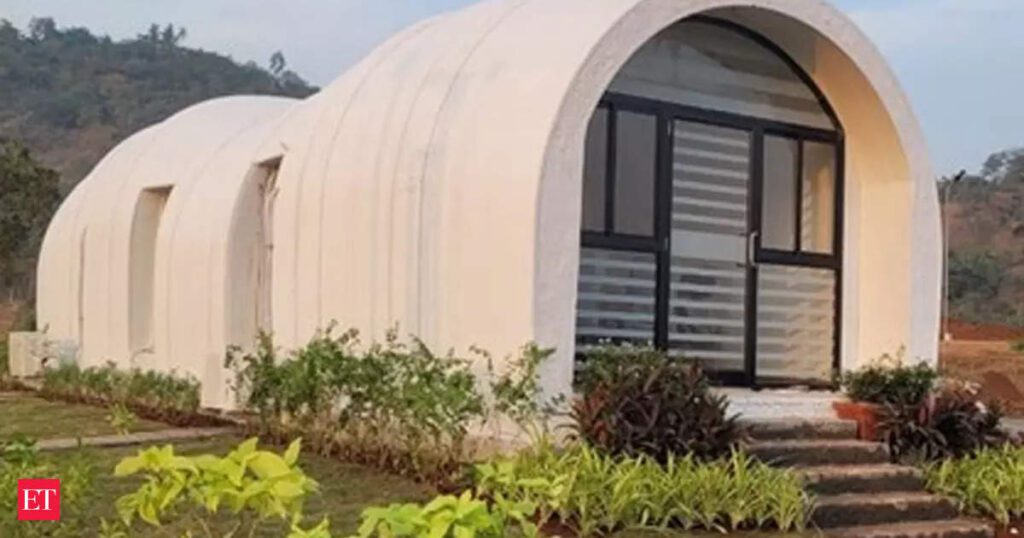
Godrej & Boyce, the flagship company of the Godrej Group, has constructed a 500 sq ft office in the company’s own greenfield campus at Khalapur near Mumbai in a 40-hour timeframe.
The First House Made With 3D Printing and AI Announced In Portugal

As we all know, additive manufacturing is being implemented in a growing number of sectors. One example is construction, where 3D printed housing is booming. In fact, soon we may see the first 3D printed house in Portugal. Not only that, but the house will be made not just using 3D printing but also artificial intelligence (AI).If you have been following us for a while, you must know that in the past two years there have been all kinds of 3D printed homes unveiled. This of course ranges from low-cost housing designed to alleviate the housing crisis to homes that have been optimized and designed to be more sustainable. In fact, it has grown so significantly that the construction 3D printing market is expected to grow in value from $3.5B in 2023 to $400 billion by 2030. Now, the company Litehaus has also decided to put its hat in the range by focusing on sustainable construction for luxury housing.A mock-up of what the house is expected to look likeMaking a House With 3D Printing and AITo be located in Torres Vedras, Portugal (only 30 minutes from Lisbon!), this house, as mentioned, will be made by combining 3D printing and AI. During the initial creation and design phase, Litheaus, has made use of AI to create the interior and exterior design of the home. This is a significant breakthrough for the construction and 3D printing industry.The manufacture of this type of modular buildings with 3D printing has a number of very important benefits. One of them is related to energy consumption. As we can well imagine, the energy consumption of a 3D printed house is lower than that of a house built by traditional methods, but how low is it in comparison? The answer is that 67% less energy is needed if the house is built in 3D. This will hopefully put a dent in the estimated 42% of carbon emissions for which the construction sector is responsible.Another big advantage is speed, as Simi Launay, creative director of Litehaus, explains, “This technology [allows] us to produce as much as 45m2 of walls in only 20 hours.” As most of the 3D printing of this home will be focus on the walls, this is not insignificant. Indeed, the hope is to build up to 100 houses a year in the country, starting from a complex of thirteen houses!Launey further explained the purpose of this project, concluding: “Litehaus is embarking on a mission to redefine living spaces, fusing AI technology, 3D printing and modular homes to create buildings that resonate with simplicity, innovation and sustainability. Our goal is to build 70% faster and 20% cheaper, delivering residences that epitomize elegance and minimalism harmonized with Portugal’s natural beauty.” You can find out more on the company’s website HERE.A look at the backyard, including a poolWhat do you think about the use of 3D printing and AI in building construction? Let us know in a comment below or on our LinkedIn, Facebook, and Twitter pages! Don’t forget to sign up for our free weekly newsletter here, the latest 3D printing news straight to your inbox! You can also find all our videos on our YouTube channel.*All Photo Credits: Liethaus
‘First-ever’ 3D printed low CO2 concrete building unveiled

First low CO2 concrete building 3D printed in Copenhagen made by 3DCP Group – a 72 m2 (775 SF) community building.
The debut of a 3D-printed, low CO2 concrete building in Copenhagen marks a transformative leap in construction methods
Partnering with 3DCP Group, AKF introduces a pioneering structure featuring environmentally friendly materials and an adaptive construction process.
Once complete, the low CO2 concrete building will house a gym, a guest room and a common laundry facility for residents.
Special low CO2 cement with 30% lower CO2 footprint was used in the concrete
To further reduce the CO2 footprint, the entire AKF project was printed using low CO2 cement, which has a carbon footprint of 30% lower than normal cement.
The low CO2 cement was mixed with local sand and gravel and turned into 3D printable concrete using the D.fab admixtures method developed by Cemex and COBOD.
Compared to 3D printing of mortars, the low CO2 cement 3D printable concrete reduces the CO2 footprint by 50%.
The low CO2 concrete building was printed using five printing days
AKF sees significant potential in 3D printing technology that goes beyond concrete and envisions a future where natural resources like clay-rich soil can be used for 3D-printed construction.
Vibeke Lorenzen, the technical director at AKF, said: “3D printing opens the door to a world of possibilities, and hopefully, we can contribute to pushing the industry’s traditional construction methods”.
Saga Architects, who also designed the first building 3DCP Group made in Denmark, strived to make the community building appear forthcoming and friendly by using a lot of wood for the decorative parts and organic shapes for the walls, a detail virtually impossible to make with conventional methods.
First 3D printed house in Portugal

The property will be located in Portela da Villa, in Torres Vedras, 30 minutes from Lisbon.3D printing focuses mainly on walls. “This technology allows us to produce up to 45m2 of walls in just 20 hours”, says Simi Launay, chief creative officer at Litehaus, quoted in a statement to which Notícias ao Minuto had access.“The process of creating this housing unit is carried out using technologies such as Artificial Intelligence, during the initial creative and design phase, and 3D printing, during the construction phase,” according to the company.3D printing is focused primarily on walls. “We are here to take away the distrust of the sector. This technology allow us to produce as much as 45m2 of walls in only 20 hours,” says Simi Launay, Litehaus’ Chief Creative Officer.Litehaus aims to build 100 homes a year in Portugal: “Our goal is to build 70% faster and 20% cheaper, delivering residences that epitomize elegance and minimalism harmonized with Portugal’s natural beauty,” adds Simi Launay.
Couple living in 3D printed concrete home for $1,400 a month reveal what it’s like
With 3D printing becoming increasingly popular, it seems a logical step that people would try to 3D print a house.One project in the Netherlands has done just, building five houses using the process in 2021, and couple Elize Lutz and Harrie Dekkers receiving their ‘digital key’.The bungalow, owned by real-estate investment company Vesteda, was being leased on six-month contracts at about $1,400 a month, Business Insider reported in 2021.Loading…The homes are certainly a departure from a bricks and mortar house, with a summary of the project describing how it wants to explore the design possibilities from 3D printing.Now obviously this is a bit different from a 3D printer you would have at home. The crane-mounted printer lays several thin layers of concrete which are stacked on top of each other, starting from the ground up.There’s no steel frame or reinforced concrete, it’s just layer after layer of concrete mix, with the 3D printing also creating cavities to provide insulation and space for wiring and plumbing.They look a bit like the filling of an oreo or an ice cream sandwich.But what are they like to actually live in?Lutz said: “I saw the drawing of this house and it was exactly like a fairytale garden,” adding: “It is beautiful.”The end result of a 3D printed house. Credit: ROB ENGELAAR/ANP/AFP via Getty ImagesDekkers added: “It has the feel of a bunker – it feels safe.”It is hoped that the structure will help provide affordable housing that’s quick to construct.In a press release, housing and spatial development alderman at the municipality of Eindhoven, Yasin Torunoglu, said: “In addition to affordable homes, the market increasingly demands innovative housing concepts.”With the 3D-printed home, we’re now setting the tone for the future: the rapid realization of affordable homes with control over the shape of your own house.”At present, this process of building houses is still not more cost effective than older ways of doing so, despite reduced labour costs.However, this is something that they hope to change in the future.This is what the houses look like when they’re finished. Credit: OB ENGELAAR/ANP/AFP via Getty ImagesIt is also hoped in the construction industry that the use of 3D printed construction could reduce the environmental impact, and also cut costs.In the Netherlands it is also a way to keep up construction as the country faces a shortage of skilled bricklayers.Construction company executive Bas Huysmans said: “If you look at what time we actually needed to print this house it was only 120 hours.“So all the elements, if we would have printed them in one go, it would have taken us less than five days because the big benefit is that the printer does not need to eat, does not need to sleep, it doesn’t need to rest.”So if we would start tomorrow, and learned how to do it, we can print the next house five days from now.”
CyBe and SAHIF to tackle South African housing crisis

20/06/2023: CyBe Construction, a leading provider of 3D concrete printers, and the South African Housing & Infrastructure Fund (SAHIF) have joined forces in a groundbreaking collaboration aimed at tackling the pressing housing shortage in South Africa. The joint effort will leverage innovative 3D concrete printing technology to deliver faster, cheaper, and more sustainable homes. This strategic cooperation comes in response to the urgent need for affordable housing and represents a significant step toward achieving the United Nations’ goal of providing safe and accessible housing for all by 2030.
South Africa’s Critical Housing Crisis
South Africa is currently facing a severe housing crisis, with an ever-increasing backlog that has persisted for years. According to Dr. Blade Nzimande, Minister of Higher Education, Science and Technology, the country currently faces a shortage of over 2.3 million houses. This backlog of affordable housing has now reached the dark milestone of persisting for over two decades, highlighting the urgent need for affordable housing solutions. Though the government is making significant progress in the provision of homes in the country, the demand for housing keeps rising every day. Unfortunately, the country’s housing crisis isn’t unique. Indonesia, for example, currently faces a shortage of over 10 million homes. Mexico needs to scale up its housing construction to 800,000 units a year to keep up with demand. India is estimated to have a housing shortage of over 38 million by 2030. It is evident that something needs to be done.
Building the Future Together
To address this critical issue, CyBe Construction (CyBe.eu) and SAHIF (sahiffund.co.za) have signed a Memorandum of Understanding (MoU), combining their expertise and resources to come to a solution. This solution can be accredited to an alternative building method to substitute conventional construction: 3D concrete printing (3DCP). 3DCP has the ability to deliver homes quicker, cheaper, and more sustainable. “We believe that construction 3D printing will significantly alter and positively disrupt how human settlements will be delivered in South Africa,” said Minister Nzimande during a demonstration of the technology by the University of Johannesburg (UJ). The university’s demonstration showcased the capabilities of the CyBe Robot Crawler: a mobile 3D printer capable of efficiently constructing homes within hours. This printer is a product of CyBe Construction, the provider of 3D printing software and hardware in the MoU issued to solve the South-African housing crisis. As a market-leading 3D concrete printer company with a decade of experience, the company has demonstrated time after time being able to offer faster, cheaper, and more sustainable construction solutions. Their demonstration at UJ reaffirmed their expertise once again, making them the ideal candidate for the cooperation with SAHIF. The South African Housing and Infrastructure Fund (SAHIF) specializes in the development and application of sustainable materials and innovative technologies in the construction sector. SAHIF is the first fund in South Africa to embrace 3DCP in their approach. The collaboration between the two sustainable innovators, planning on rolling out large-scale development projects around the country, is poised to transform South Africa’s construction industry.
Turning Adversity into Progress
Though the collaboration between Cybe and SAHIF was being planned and prepared for some time now, the inauguration of the MoU still had a rather coercive trigger. The occurrence that lifted the agreement of the ground was a recent earthquake in South Africa. The seismic event, of which the epicenter is believed to be in Johannesburg’s neighboring city Boksburg, caused extensive damage to buildings in a large scale around the city. The earthquake served as the final push for the initiation of the MoU. SAHIF’s CEO, Rali Mampeule, emphasized the pressing need for affordable but resilient housing by stressing that “not only are 3D printed houses more affordable and quicker to build, but we also know they are sturdy enough to withstand seismic forces that took us by surprise this week.”
Earthquake-Proof Structures with 3D Printing
The adoption of 3D concrete printing technology provides a groundbreaking solution for constructing earthquake-resistant houses in South Africa. The inherent flexibility of 3DCP allows for the customization of structures, specifically tailored to withstand seismic activity. The technique also allows for the creation of intricate shapes that are reinforced with earthquake-resistant materials such as steel or polymer. The key factor in the method’s ability to absorb the seismic energy of an earthquake, however, can be attributed to CyBe Construction’s building material. The company has developed its own CyBe Mortar, an earthquake-proof mortar specifically formulated for 3D printing. This material combines high-strength aggregates and fibers, significantly bolstering its resistance to seismic forces. With superior durability and flexibility, this material stands out as an ideal option for constructing earthquake-proof houses. Additionally, its reduction of CO2 emissions by 32% as compared to traditional cement-based mortars promotes sustainability in the construction industry. This earthquake-resistant material, when combined with the precision, efficiency, and flexibility of 3D concrete printing, creates homes that not only prioritize safety but also showcase sustainability and style.
Fast, Affordable, and Sustainable Construction
The benefits of 3D concrete printing extend far beyond earthquake-proofing. The technique enables faster, cheaper, and more sustainable construction, making it an ideal solution for addressing the housing shortage in South Africa. The method almost entirely automates construction, resulting in significant time and labor hour savings. It also ensures optimal material usage, meaning less waste and lower material costs. This lower waste, along with the use of eco-friendly materials, contributes to more sustainable construction practices. CyBe Construction brings over ten years of experience in 3D concrete printing, offering a wealth of expertise and know-how in this cost-effective, efficient, and sustainable construction method. This makes them the perfect entity to work together with SAHIF. Combining SAHIF’s proficiency in South African construction and CyBe Construction’s competence in 3D concrete printing, the parties are well-equipped to address the pressing housing crisis in the country.
A Blueprint for Housing Success
The collaboration between CyBe Construction and SAHIF represents a significant milestone in addressing South Africa’s housing shortage. The transformative power of 3D concrete printing technology, with its ability to deliver faster, cheaper, and more sustainable homes, holds immense promise for the construction industry. As the urgent need for affordable housing is not bound to South Africa, as demonstrated by the housing backlogs in countries like Indonesia, Mexico, and India, the cooperation is poised to revolutionize the way homes are built not only in South Africa but also worldwide. With its proven effectiveness, 3D concrete printing can offer a scalable and efficient solution to this pressing global challenge, and the collaboration between CyBe and SAHIF can be seen as a precedent for solving the global housing crisis. By combining innovation, expertise, and a shared vision, CyBe Construction and the South African Housing and Infrastructure Fund are leading the way towards a future where safe, accessible, and sustainable housing is within reach for all.
The world’s tallest 3D printed building
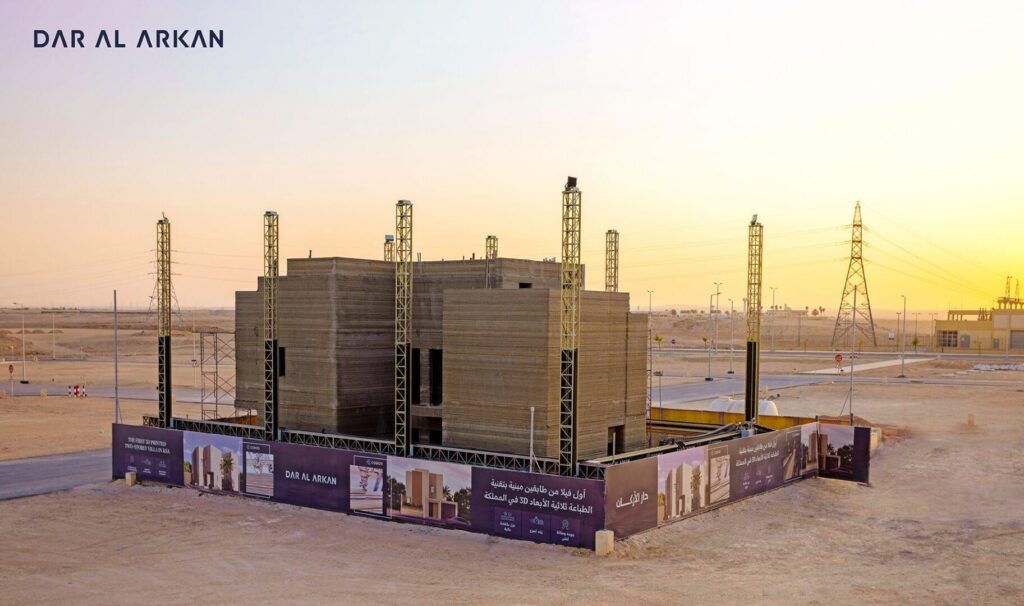
The 345 m2 building was 3D printed by the leading Saudi Arabian real estate developer, Dar Al Arkan, using a COBOD 3D construction printer The building has a total height of 9.9m and is therefore also the tallest on-site 3D printed building in the world Low cost local materials were used at a cost of […]
PERI live 3D printing with COBOD printer was the highlight at bauma
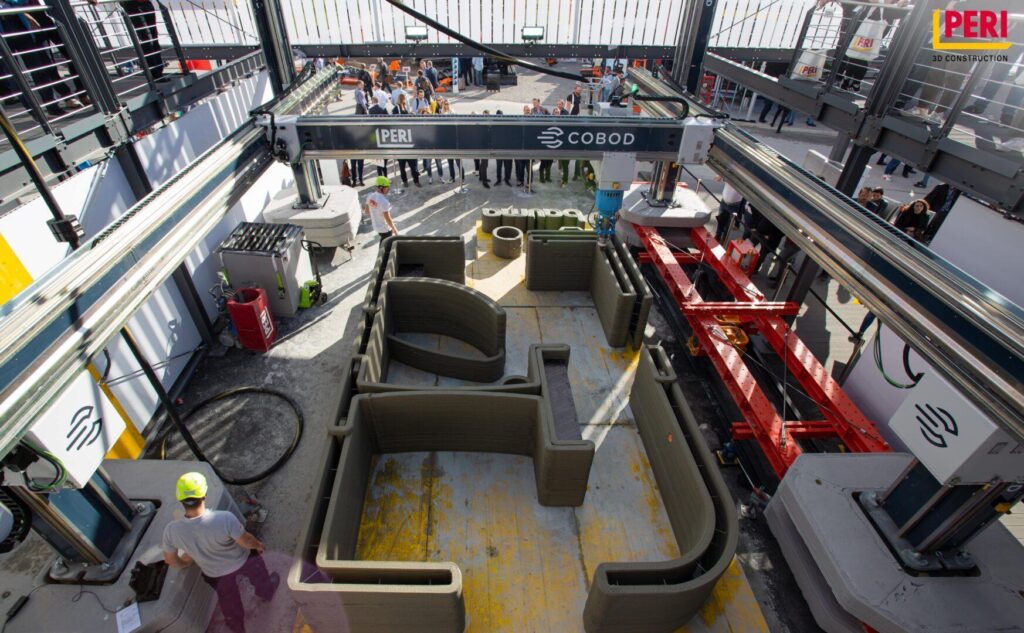
In an unprecedented showcase PERI took it upon themselves to live 3D print the walls of a small house each day for 7 days at the Bauma exhibition last week in Munich, Germany the largest construction exhibition in the world More than 600,000 visitors from 200 countries attended the exhibition, with over 300,000 coming to […]
Record speed: GUtech Oman 3D prints three new buildings in just 8 days
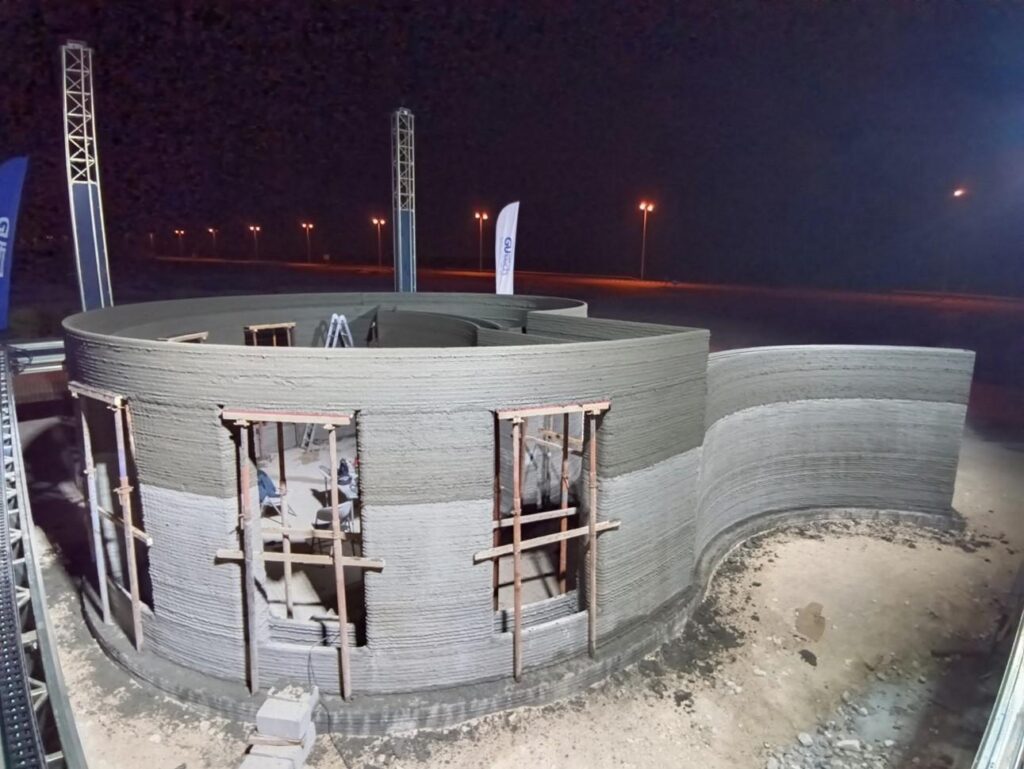
The first 3D printed coffee shop in the world, a public restroom and a Fisherman’s house was 3D printed in respectively 22, 13 and 19 hours and the total duration including movements of the printer was 8 days. A total of 173 m2 (1,851 SF) of buildings were made with a cost for the concrete […]
Danish construction robot challenges masons across the world
The layer is about 10 cm/ 3,93701 inches wide and 4 cm/1,5748 inches high. The robot’s mouthpiece lays the concrete layer upon layer up to 1 meter/ 3 feet per second, exactly as it is drawn in a computer program. It can turn into a new house or the foundation of a wind turbine. Today it […]
EUROPE’S LARGEST 3D PRINTED BUILDING
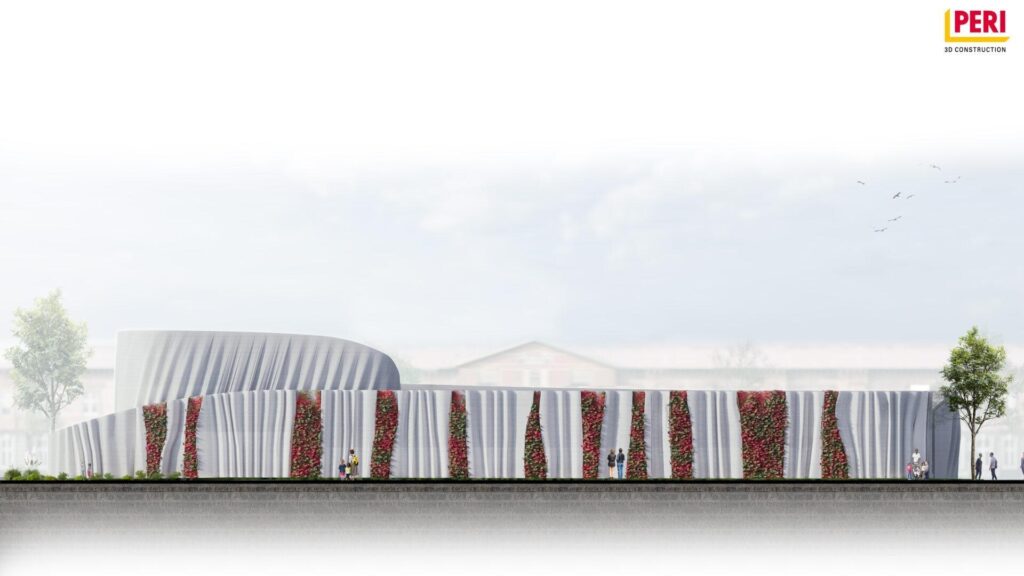
Europe’s largest 3D printed building is being constructed by PERI in the city of Heidelberg, Germany, with COBOD’s BOD2 printer. The building is almost 600 m2 (6600 sft), 54m (162 ft) long, 11m (121 ft) wide and 9m (30 ft) high and contains an IT server hotel The project is made for Heidelberg IT Management […]
Rebuilding Ukraine with a 3D Printed School
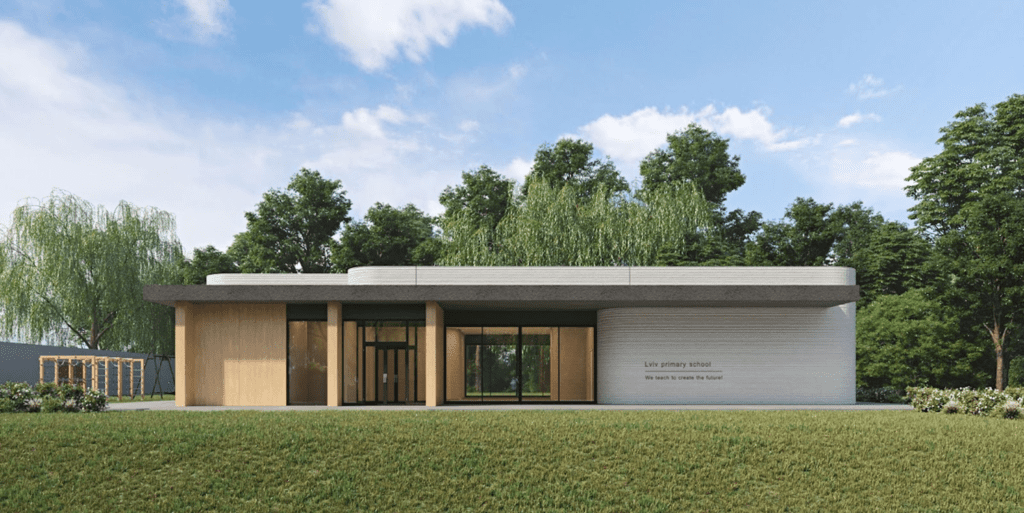
3D construction printing is helping Ukraine to rebuild faster The first-ever on site 3D printed building in Ukraine is being made in Lviv The 3D printed primary school in Lviv is also the first 3D printed school in Europe The one-story building with total floor area of 370 m2/3982,65 ft2 half of the printing is […]
PERI STARTS EUROPES FIRST 3D PRINTED PUBLIC BUILDING
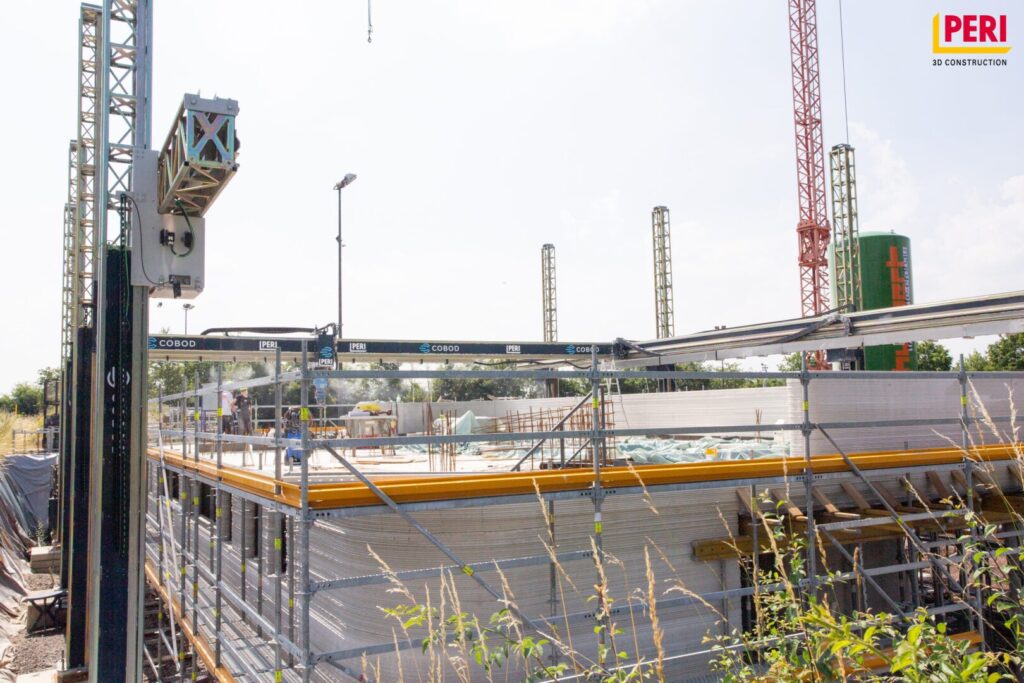
Europe’s first 3D printed public building and football clubhouse Europe’s first 3D printed public building and football clubhouse 330 m2 (3.550 SF) on 2 floors planned to be printed in 140 hours Printed by a BOD2 3D construction printer from COBOD measuring 25 m (83 feet) in length, 15 m (50 feet) in width and […]
Europe’s First 3D Printed Publicly Funded House
First 3D social housing apartment building in Germany and Europe. The three floors building contains a total of 651 m2 (7.150 SF) and will have six apartment units between 61 m2 (670 SF) and 81m2 (890 SF). Third project from PERI 3D Construction in Germany this year using COBOD’s 3D construction printer, where the technology […]